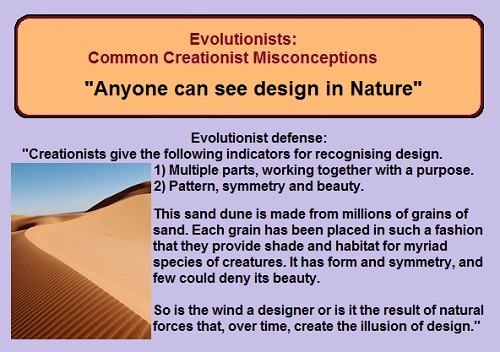Meme:
Anyone can see design in Nature
Link to this topic: http://rationalfaith.com/2017/07/unmasking-mistakes-in-memes-of-evolution-part-4-evolutionists-blind-to-the-obvious/#design_in_nature

First, well known atheist and evolutionist Richard Dawkins, though he probably won't admit it, makes a nice case for the design apparent in nature. In his book "The Blind Watchmaker" Dawkins defines biology as, "...the study of complicated things that give the appearance of having been designed for a purpose.”[8] In this one statement Dawkins refutes the entire premise of the evolutionary argument in this meme. But first, let's look at what he acknowledges as true in this statement.
By saying biology is a study of
"complicated things" with the appearance of being "designed for a
purpose" Dawkins acknowledges:
1. Many biological systems are complex
2. Design can be recognized, otherwise there could be no
"appearance of design" because one could never recognize design
3. The design is meant to achieve a purpose, and that purpose is
apparent.
You'll note that by this definition, the sand dune does not meet the definition of "designed." Millions of pieces of an item does not imply complexity. Nor does mere symmetry. Suppose millions of drops of water fall on either side of a hill forming two round pools. The fact that there are millions of drops, and that the pools are symmetrical does not imply design. Neither does the millions of grains of sand in the sand dune above. Also note that the fact that the sand dune can be used for a purpose - like for shade or a habitat - does not mean it was "designed for a purpose." The two pools of water I mentioned can be used to swim in. That does not mean they were designed to be swimming pools.
So the writer of this evolutionary defense is totally ignorant of basic concepts of what creationists mean by "design in nature."
Second, the inference of design has come a long way, led by Intelligent Design advocates such as William Dembski. Beyond mere symmetry coupled with complexity, Demski notes there are three specific criteria required to be met before being justified in making an inference of design:
“Whenever we infer design, we must establish three things: contingency, complexity, and specification. Contingency ensures that the object in question is not the result of an automatic and therefore unintelligent process that had no choice in its production. Complexity ensures that the object is not so simple that it can readily be explained by chance. Finally specification ensures the object exhibits the type of pattern characteristic of intelligence.”[9]
The sand dune example fails on all 3 requirements of this definition: It is not contingent - it can in fact be the process of unintelligent processes; it is not complex - it can in fact be readily explained by chance, and finally there is no specification - there is no particular pattern it's matching. [10]
So this rather puerile attempt to refute design in nature fails whether you approach it from atheist assumptions, or from intelligent design assumptions. It in no ways refutes apparent design in nature in things like DNA, the bacterial flagellum, the blood clotting cascade, etc. But this feeble and fallacious argument does offer up other lessons: 1. This is a classic straw man argument - the arguments presented are, like a straw man - easily knocked down, and though not representative of what the opposing view (intelligent design) states, is used anyway for what appears to be an easy knock down victory for the one employing the fallacy (evolutionists) 2. Don't be surprised when evolutionists misrepresent the views of creationists and intelligent design advocates. They do it fairly often, so you must be constantly vigilant like the Bereans (Acts 17.11) to check what they're saying to see if they're presenting facts and views correctly and accurately.
In these items, evolutionists are clearly and obviously wrong. Once again the scriptures have said it best:
The heavens declare the glory of God; the skies proclaim the work of his hands.
2 Day after day they pour forth speech; night after night they display knowledge.
Ps 1.1-2
For since the creation of the world God's invisible qualities--his eternal power and divine nature--have been clearly seen, being understood from what has been made, so that men are without excuse.
Rom 1.20
Duane Caldwell | posted 5 July, 2017
Follow @duanecaldwell